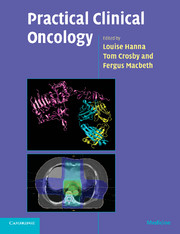Book contents
- Frontmatter
- Contents
- List of contributors
- Preface
- Acknowledgements
- Abbreviations
- 1 Practical issues in cytotoxic chemotherapy usage
- 2 Biological treatments in cancer
- 3 Hormones in cancer
- 4 Radiotherapy planning
- 5 Research in cancer
- 6 Oncological emergencies
- 7 Palliative care
- 8 Head and neck
- 9 Oesophagus
- 10 Stomach
- 11 Liver, gallbladder and biliary tract
- 12 Exocrine pancreas
- 13 Colon and rectum
- 14 Anus
- 15 Gastrointestinal stromal tumours
- 16 Breast
- 17 Kidney
- 18 Bladder
- 19 Prostate
- 20 Testis
- 21 Penis
- 22 Ovary
- 23 Body of the uterus
- 24 Cervix
- 25 Vagina
- 26 Vulva
- 27 Gestational trophoblast tumours
- 28 Lung
- 29 Mesothelioma
- 30 Soft tissue and bone tumours in adults
- 31 The lymphomas and myeloma
- 32 Central nervous system
- 33 Skin cancer other than melanoma
- 34 Melanoma
- 35 Thyroid
- 36 Neuroendocrine tumours
- 37 Cancer in children
- 38 Cancer of unknown primary
- 39 The use of radiotherapy in the treatment of benign conditions
- Multiple choice questions
- Multiple choice answers
- Index
- References
34 - Melanoma
Published online by Cambridge University Press: 23 December 2009
- Frontmatter
- Contents
- List of contributors
- Preface
- Acknowledgements
- Abbreviations
- 1 Practical issues in cytotoxic chemotherapy usage
- 2 Biological treatments in cancer
- 3 Hormones in cancer
- 4 Radiotherapy planning
- 5 Research in cancer
- 6 Oncological emergencies
- 7 Palliative care
- 8 Head and neck
- 9 Oesophagus
- 10 Stomach
- 11 Liver, gallbladder and biliary tract
- 12 Exocrine pancreas
- 13 Colon and rectum
- 14 Anus
- 15 Gastrointestinal stromal tumours
- 16 Breast
- 17 Kidney
- 18 Bladder
- 19 Prostate
- 20 Testis
- 21 Penis
- 22 Ovary
- 23 Body of the uterus
- 24 Cervix
- 25 Vagina
- 26 Vulva
- 27 Gestational trophoblast tumours
- 28 Lung
- 29 Mesothelioma
- 30 Soft tissue and bone tumours in adults
- 31 The lymphomas and myeloma
- 32 Central nervous system
- 33 Skin cancer other than melanoma
- 34 Melanoma
- 35 Thyroid
- 36 Neuroendocrine tumours
- 37 Cancer in children
- 38 Cancer of unknown primary
- 39 The use of radiotherapy in the treatment of benign conditions
- Multiple choice questions
- Multiple choice answers
- Index
- References
Summary
Introduction
Melanocytes originate in the neural crest of the embryo and migrate widely during development to locations such as the basal layer of the epidermis and the uveal tract. As a result of this migration, malignant melanoma (MM) can affect sites in addition to the skin, including the central nervous system (e.g. meninges and uveal tract) and the aerodigestive and genitourinary tracts (e.g. nasopharynx, oral cavity and vagina).
The incidence of cutaneous melanoma has increased by 50% in the past two decades, although there are significant geographical variations, and it is about ten-fold higher in white than in non-white populations. Despite the rise in incidence, mortality has plateaued and even fallen in some populations, for instance in women and young men in Australia (Giles et al., 1996). During the same period, there has been a six-fold increase in melanoma in situ, suggesting improvement in earlier detection.
This chapter focuses on cutaneous and ocular melanoma.
Cutaneous melanoma
Types of cutaneous melanoma
The main clinicopathological varieties of MM are superficial spreading, nodular, acral lentiginous and lentigo maligna melanoma.
Incidence and epidemiology
Annual disease incidence in the UK is 8 in 100,000 patients. Approximately 8000 new cases are diagnosed per year in England and Wales. Cutaneous melanoma accounts for 3% of all cancers, with approximately 1800 deaths occurring annually.
There has been a 50% increase in the number of new cases diagnosed over the past four decades, although mortality has plateaued in some populations.
- Type
- Chapter
- Information
- Practical Clinical Oncology , pp. 395 - 405Publisher: Cambridge University PressPrint publication year: 2008



